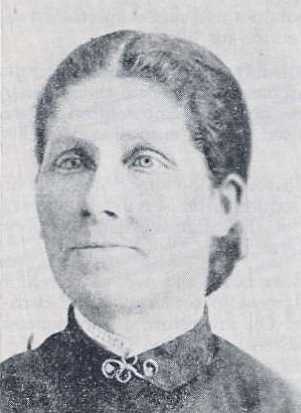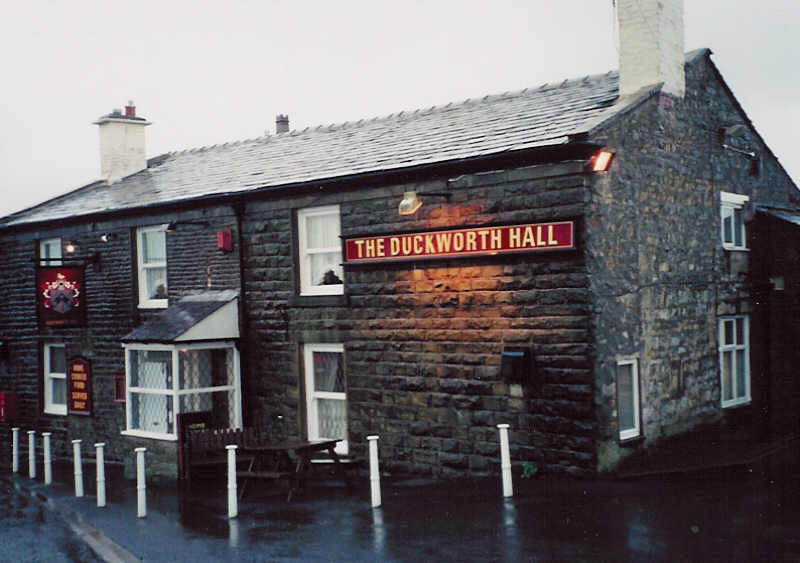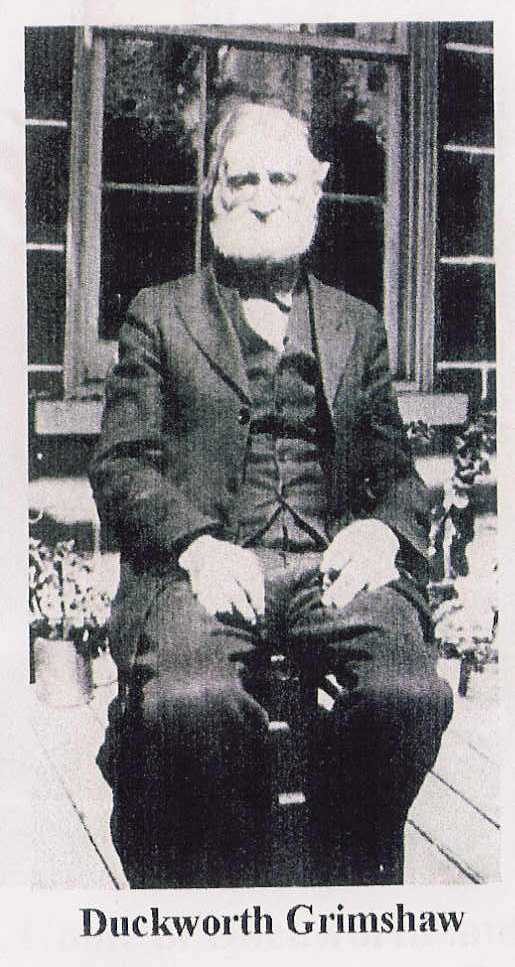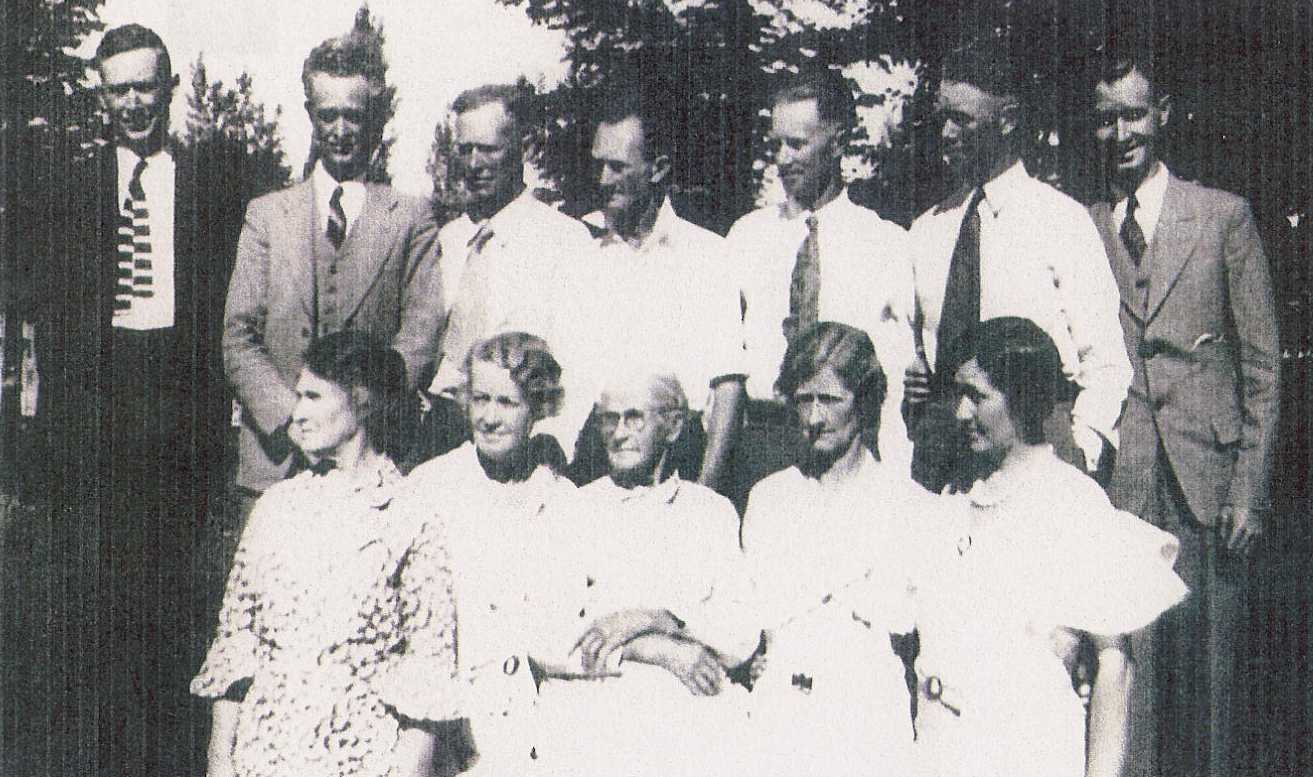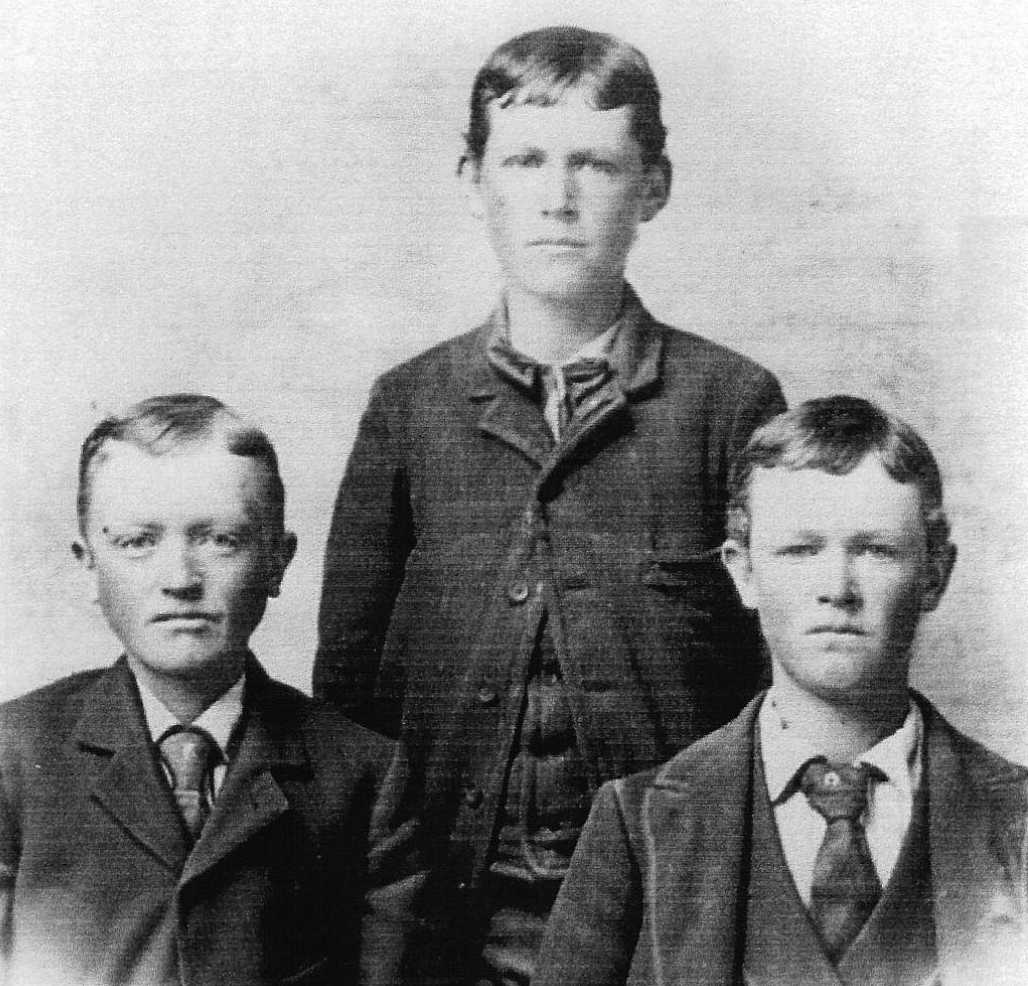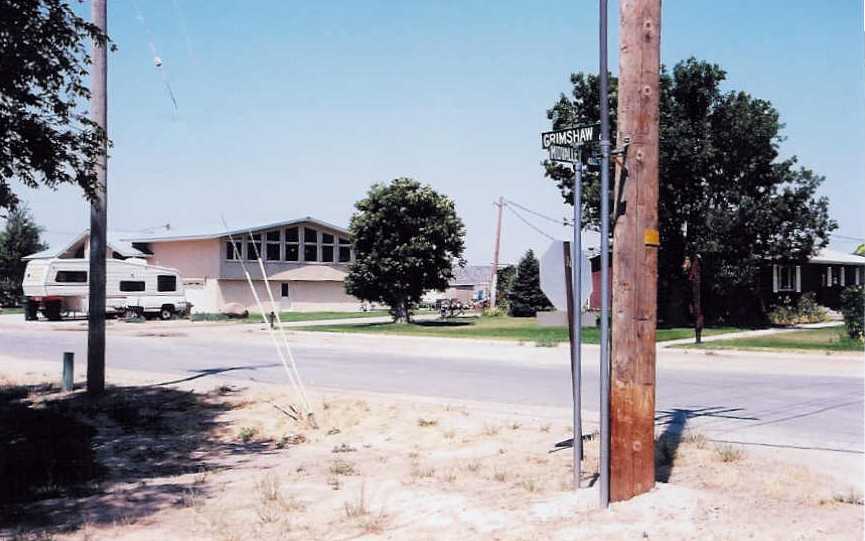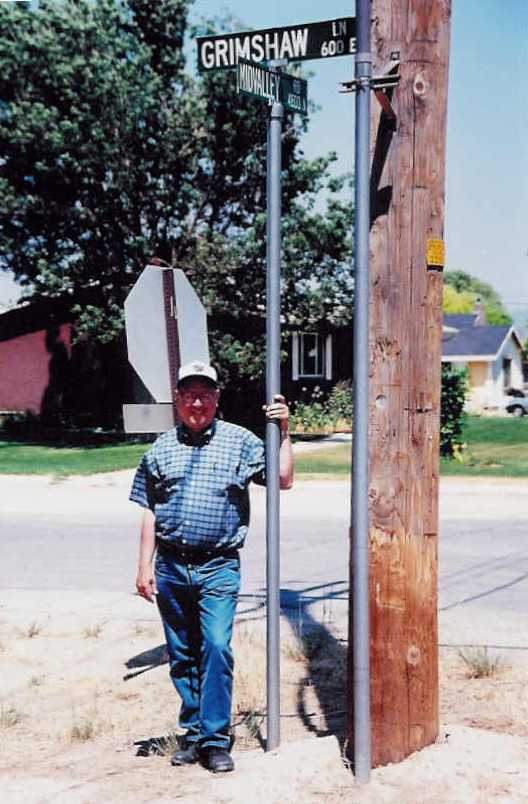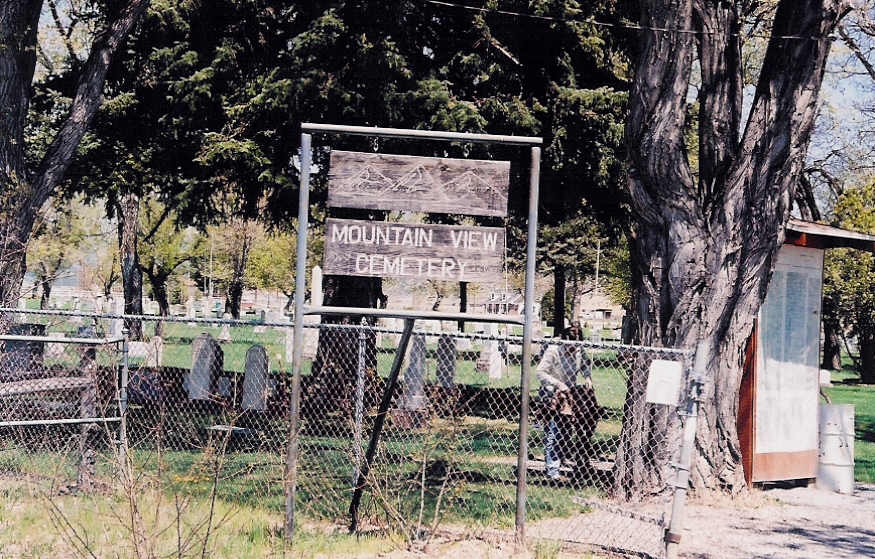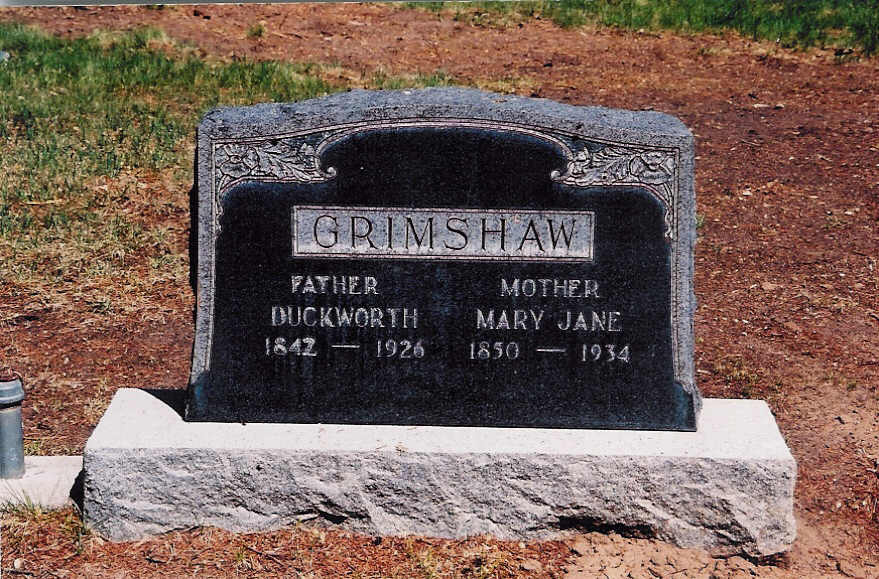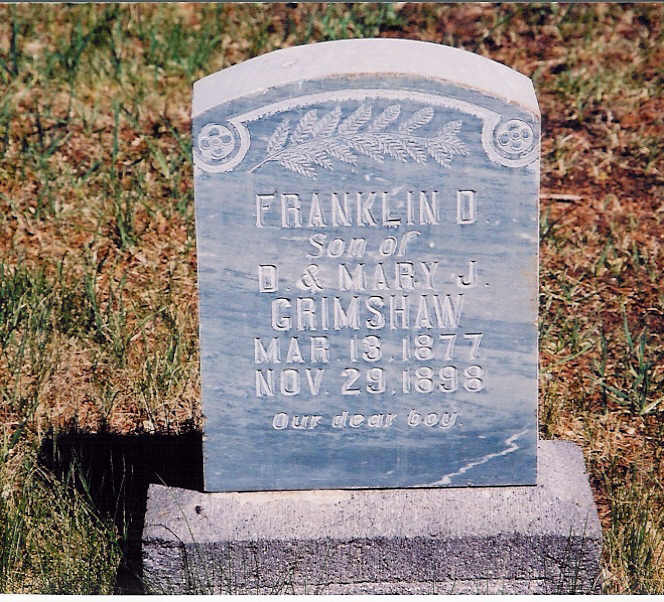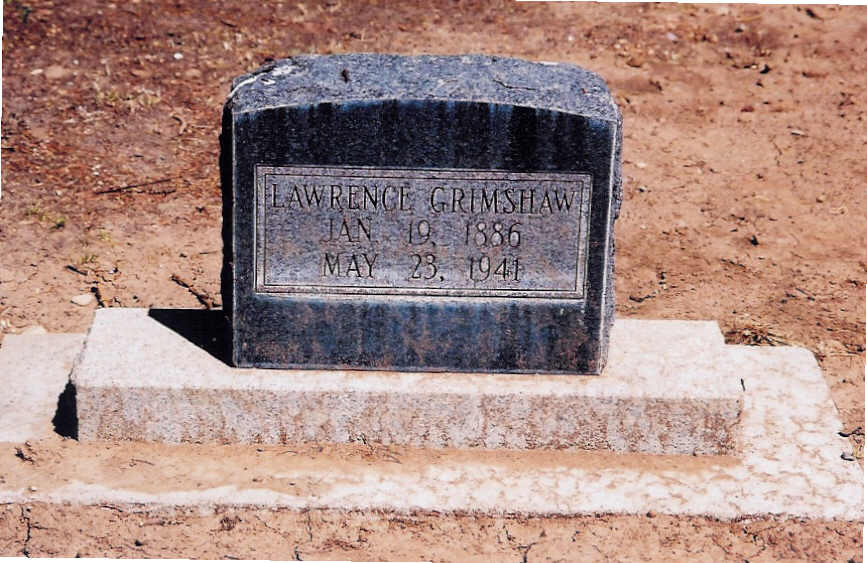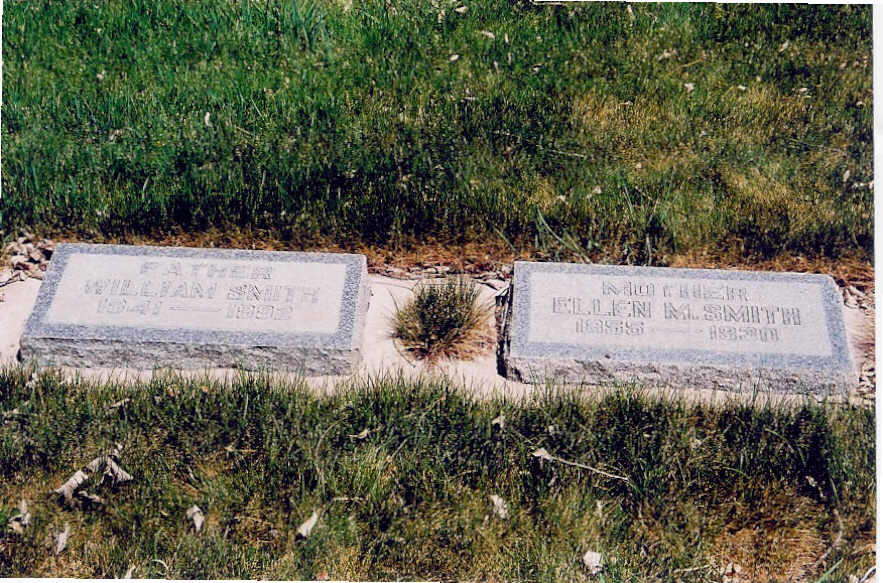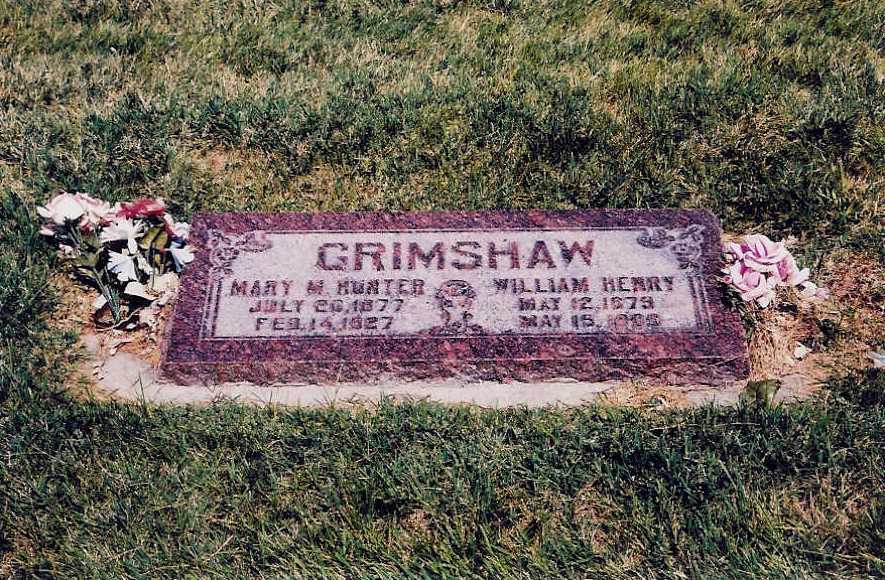Duckworth & Mary Jane (Moyes)
Grimshaw, Mormon Immigrants to Beaver, Utah
Duckworth Grimshaw was born in Tottington, Lancashire in 1842 and worked in textile mills in that area before leaving for America. His parents were from Accrington (just south of Clayton-le-Moors) and converted to Mormonism in about 1838, shortly after the faith was introduced in England. Duckworth joined the Mormon church in 1860 and emigrated to Utah in 1862. His parents followed in 1863.
A companion webpage has been prepared for Duckworth’s parents, Lawrence and Alice (Whitaker) Grimshaw, who had other descendants who were immigrants to America. One of these descendants was Duckworth’s uncle, also named Duckworth, who is also described on another companion webpage.
Contents
The Records of Duckworth Grimshaw
Photos of Duckworth and Mary Jane (Moyes) Grimshaw
Family Tree of Duckworth and Mary Jane Grimshaw
Where Did Duckworth Get Such an Unusual Name?
Additional Photos of Duckworth Grimshaw’s Descendants
Photo of Duckworth and Ellen Muir Smith Grimshaw’s Son
William Henry Grimshaw, Inventive Homesteader of Iron County, Utah
One of Duckworth’s many descendants was John L Grimshaw, who flew a fighter plane in World War II and is described on a companion webpage.
Webpage Credit
Thanks go to Keith Grimshaw, current resident of Grimshawville, which is near Enoch and north of Cedar City, Utah, for providing information and directions to the homesite of William Grimshaw, son of Duckworth and Mary Jane Grimshaw.
The Records of Duckworth Grimshaw
A summary of Duckworths life, based on his own journals and notes of some of his close relatives, was published by the Daughters of Utah Pioneers in 19691. A portion of it is included at the bottom of this webpage. The description of his life before leaving for the U.S. provides interesting insight into the quality of life for people living in the Industrial Revolution in England during the mid-1800s. The autobiographical records also provide a clear window into the life of early settlers in Utah.
Another noteworthy feature of Duckworths life was his polygamy. His records include a description of the year that he spent in the Utah penitentiary for violation of the Edmunds-Tucker Act. His second wife was Ellen Muir Smith Grimshaw.
Photos of Duckworth and Mary Jane (Moyes) Grimshaw
Photos of Duckworth and Mary Jane are provided in the Records of Duckworth Grimshaw1 and are shown in Figure 1 below.
Figure 1. Photos of Duckworth and Mary Jane Grimshaw.
Family Tree of Duckworth and Mary Jane (Moyes) Grimshaw
The family tree for Duckworth and Mary Jane Moyes Grimshaw is summarized in Figure 2 from LDS Ancestral File records. Duckworth had 13 children with Mary Jane and one child with Ellen – Thomas Duckworth Grimshaw. Thomas remained unmarried, and there were no descendants from this second family. The descendant chart also presents the ancestors and other family members of this important Grimshaw family. To the author’s knowledge, this family has not yet been “tied back” to the original Grimshaw family line.
Figure 2. Descendant Chart for Duckworth and Mary Jane Grimshaw, showing also Duckworths’ Grimshaw ancestors.
George Grimshaw (About 1739 – ) & Betty (About 1741 – )
|—–Thomas Grimshaw (About 1765 – ) & Susan Fielden (About 1769 – )
|—–|—–Lawrence Grimshaw (6 Oct 1782 – ) & Mary Duckworth (4 Apr 1786 – )
|—–|—–|—–John Grimshaw* (12 Jun 1811 – ) & Alice Whittaker (28 Dec 1809 – )
|—–|—–|—–|—–James Grimshaw (20 Feb 1837 – )
|—–|—–|—–|—–Mary Grimshaw (9 Mar 1838 – ) & William Atkinson (About 1834 – )
|—–|—–|—–|—–Duckworth Grimshaw* (3 Mar 1842 – ) & Mary Jane Moyes (6 Jun 1850 – )
|—–|—–|—–|—–|—–John Grimshaw (15 Mar 1868 – ) & Mary Elizabeth Bradfield (28 Apr 1872 – )
|—–|—–|—–|—–|—–Elizabeth Alice Grimshaw (7 May 1870 – ) & Archibald Wardrobe Fotheringham (6 Aug 1867 – )
|—–|—–|—–|—–|—–Mary Ann Grimshaw (19 Aug 1872 – ) & Josiah Rogerson (21 Sep 1867 – )
|—–|—–|—–|—–|—–Martha Jane Grimshaw (6 Jan 1875 – ) & William Thomas Rogerson (17 Mar 1866 – )
|—–|—–|—–|—–|—–Franklin Duckworth Grimshaw (18 Mar 1877 – )
|—–|—–|—–|—–|—–William Henry Grimshaw (12 May 1879 – ) & Mary May Hunter (20 Jul 1877 – )
|—–|—–|—–|—–|—–Ray Grimshaw (12 Jun 1881 – ) & Hannah Maria Farrow (18 Apr 1881 – )
|—–|—–|—–|—–|—–Ida Grimshaw (15 Jan 1884 – ) & Carl Herman Ehninger (About 1880 – )
|—–|—–|—–|—–|—–Lawrence Grimshaw* (19 Jan 1886 – ) & Mary Dell Parkinson (18 Oct 1889 – )
|—–|—–|—–|—–|—–Lawrence Grimshaw* (19 Jan 1886 – ) & Irene Groves (About 1890 – )
|—–|—–|—–|—–|—–May Grimshaw (1 May 1888 – ) & Willard Clausen Jensen (2 Jun 1868 – )
|—–|—–|—–|—–|—–Arnold Grimshaw (2 Sep 1890 – ) & Myrtle Hodges (30 Aug 1892 – )
|—–|—–|—–|—–|—–Randolph Grimshaw (28 Dec 1893 – ) & Estella Jones (29 Oct 1893 – )
|—–|—–|—–|—–|—–George Whittaker Grimshaw (22 Feb 1896 – ) & Leona Armstrong
|—–|—–|—–|—–Duckworth Grimshaw* (3 Mar 1842 – ) & Ellen Muir (About 1846 – )
|—–|—–|—–|—–|—–Thomas Duckworth Grimshaw (7 Jul 1891 – )
|—–|—–|—–|—–Susanna Grimshaw (18 Dec 1845 – )
|—–|—–|—–|—–? Grimshaw (5 Jan 1849 – )
|—–|—–|—–|—–Sarah Ann Grimshaw (5 Jan 1849 – ) & Joseph Hyrum (5 Mar 1845 – )
|—–|—–|—–|—–? Grimshaw (5 Jan 1849 – )
|—–|—–|—–|—–Elizabeth Grimshaw* (27 Feb 1849 – ) & Richard Greenhalgh (27 Jul 1838 – )
|—–|—–|—–|—–Elizabeth Grimshaw* (27 Feb 1849 – ) & David Davis Rees (19 Oct 1828 – )
|—–|—–|—–|—–Elizabeth Grimshaw* (27 Feb 1849 – ) & Richard Greenalch (About 1845 – )
|—–|—–|—–|—–Alice Grimshaw (7 Jan 1852 – ) & James William Atkin (10 Jul 1845 – )
|—–|—–|—–John Grimshaw* (12 Jun 1811 – ) & Mary Ann Orill (About 1813 – )
|—–|—–|—–John Grimshaw* (12 Jun 1811 – ) & Elizabeth Ranklin (About 1813 – )
|—–|—–|—–Elizabeth Grimshaw (11 Dec 1812 – )
|—–|—–|—–Faith Grimshaw (6 Oct 1813 – )
|—–|—–|—–Faith Grimshaw (20 Dec 1814 – )
|—–|—–|—–Faith Grimshaw (29 Mar 1817 – )
|—–|—–|—–Mary Grimshaw (24 Feb 1820 – ) & John Whittaker (About 1816 – )
|—–|—–|—–|—–Duckworth Whittaker (24 Feb 1822 – )
|—–|—–|—–|—–Isabel Whittaker (6 Apr 1824 – )
|—–|—–|—–Duckworth Grimshaw (24 Feb 1822 – )
|—–|—–|—–Isabel Grimshaw (6 Apr 1824 – )
|—–|—–|—–Susannah Grimshaw (14 Feb 1826 – ) & William Robinson (16 Sep 1831 – )
|—–|—–|—–|—–Mary Ann Robinson (25 Aug 1856 – )
|—–|—–|—–|—–Jesse Benjamin Robinson (12 Sep 1858 – ) & Francis Skinner (29 Jun 1860 – )
|—–|—–|—–|—–Joseph Robinson Robinson (1 Aug 1861 – )
|—–|—–|—–|—–Emma Robinson (1 Aug 1861 – )
|—–|—–|—–|—–? Robinson (About 1863 – )
|—–|—–|—–|—–? Robinson (About 1863 – )
|—–|—–|—–William Grimshaw (6 Nov 1828 – )
Where Did Duckworth Get Such an Unusual Name?
Duckworth was given as his first name the surname of one of his maternal ancestors. Like Grimshaw, Duckworth is a Lancashire name of long standing. Duckworth Hall is located southeast of Blackburn within a few miles of the Grimshaw location; it is shown in Figure 3 below.
Figure 3. Duckworth Hall, located just northeast of the Grimshaw location in Eccleshill. Its location can be seen on the map of the area, presented on a companion webpage.
Additional Photos of Duckworth Grimshaw’s Descendants
A genealogical publication for the Moyes family2 includes a number of additional photos of Duckworth and Mary Jane’s family. They are shown in Figures 4, 5, and 6 below.
Figure 4. Duckworth and Mary Jane in their older years. Dates of photos unknown.
Figure 5. Duckworth and Mary Jane Grimshaw’s family. Back row, left to right: John, Will, Ray, Lawrence, Arnold, Dolph, George W. Front row, left to right: Elizabeth, Jane, Mary Jane (mother), Ida, May
Figure 6. Frank, Ray and Will Grimshaw (L to R)
Photo of Duckworth and Ellen Muir Smith Grimshaw’s Son
The Records of Duckworth Grimshaw1 includes a photo of Duckworth’s son by his second wife, Ellen. It is shown in Figure 7.
Figure 7. Thomas Duckworth Grimshaw
William Henry Grimshaw, Inventive Homesteader of Iron County, Utah
William Henry Grimshaw, 6th child of Duckworth and Mary Jane, and his wife, Mary May (Hunter) Grimshaw, settled in Iron County, south of Beaver, Utah, in the early 1900s. As described in a history of Iron County3, the town of Grimshawville existed near Enoch, Utah until 1956 (p. 172):
Grimshawville
According to local history, William H. Grimshaw wandered through Cedar Valley in 1902 looking for the tallest sagebrush. He found it north and west of Enoch, and there he homesteaded. He and his wife brought honeybees and planted corn and alfalfa. Soon they discovered bees and alfalfa-seed-raising thrived together, and so they went into the seed business with what was described as phenomenal success during the good water years. Many families moved to the area to plant alfalfa, but later years of water shortage caused many of the fields to die out. Grimshawville became part of Enoch Town when it was incorporated in 1956.
William was apparently quite inventive in early technology (p. 98-99):
Telephone lines reached Parowan and Cedar City in the summer of 1903. Although there were few private telephones for several years, Cedar City and Parowan were connected to major communities northward as far as Montana in August 1903. John S. Woodbury was the first manager of Cedar City’s telephone company.
After a line was built from Cedar City to Enoch in 1905, William H. Grimshaw decided to have a telephone in his home northwest of Enoch. The cost of bringing a line to his home was more than he wanted to pay, so Grimshaw used the wire fences which enclosed the fields as his telephone line. Wherever there was a road, gate, or gap in the fence, he bridged it with extensions and insulators on the posts on each side. After he had connected his home via the fences to the central office, he asked Woodbury to bring out a phone. Woodbury was somewhat skeptical and said if he installed it Grimshaw would have to pay the monthly rate whether it worked or not. Grimshaw agreed and after installation rang up central and heard the voice of Arabella Jones saying, (‘Number, please? Who is this?” Grimshaw responded, “This is William H. Grimshaw on Linger Longer Lane talking on the barbed wire fence.” “You are?” she said. “Oh, Mr. Grimshaw, its coming in just as clear as if it was on smooth wire.” Afterwards, many families used this method to connect their valley farms to the telephone system.
Further evidence of William’s technological bent (in this case, water well drilling) is also described in the county history (p. 100-101):
In 1906 Will and May Grimshaw took beehives to a homestead in Midvalley and soon discovered that bees and alfalfa-seed-raising went together. The Matheson brothers – William, Lorenzo, Owen, and Daniel – followed and homesteaded northwest of the Grimshaws. In 1910 the Stevens brothers settled in the area and raised horses and cattle. During high-water years, the Midvalley farms flourished, but water shortages caused the fields of alfalfa to die out. Culinary wells were drilled by Johnny Lang, Will Grimshaw, and Owen Matheson.
Keith Grimshaw, proprietor of a motorcycle and four-wheeler shop at the Grimshawville location near Enoch, directed the author to the homesite of William. Although the home is no longer in existence, the adjacent road is named Grimshaw Lane (Figure 8)
Figure 8. Scenes from the area around William Grimshaw’s homesite at Grimshawville, near Enoch, Utah. All photos taken June 2002 by website author.
a. Northeastward view of corner of Grimshaw Lane and Midvalley Road in Grimshawville. The two buildings across the road occupy the former homesite of William Grimshaw. Note the street sign indicating Grimshaw Lane.
b. Closer view of street sign, showing “Grimshaw Lane” more clearly. Taken in same direction as previous photo.
c. Close-up view of Grimshaw Lane street sign.
Final Resting Places
Duckworth and Mary Jane, and several of their children and later descendants, are buried in Mountain View Cemetery in Beaver, Utah. Figures 8 and 9 are photos of the cemetery entrance and of Duckworth and Mary Jane’s grave. Graves of their children are shown in Figures 10 and 11. The final resting place of Thomas Duckworth Grimshaw, son of Duckworth and Ellen Muir Smith Grimshaw is located near his mother’s grave (Figure 12.) Her grave is adjacent to that of her first husband, William Smith (Figure 13.)
The graves of Duckworth’s parents and sister, Susannah Grimshaw Robinson, are also in Mountain View Cemetery and are shown on the webpage of Duckworth’s grandparents, Lawrence and Mary (Duckworth) Grimshaw.
Figure 9. Entrance to Mountain View Cemetery, Beaver, Utah. The list of occupants on the board (right side of photo) includes no fewer than 23 Grimshaws
Figure 10. Gravestone of Duckworth and Mary Jane (Moyes) Grimshaw
Figure 11. Graves of John Grimshaw, oldest son of Duckworth and Mary Jane, and his wife, Mary Elizabeth (Bradfield) Grimshaw
Figure 12. Graves of Franklin Duckworth Grimshaw and Lawrence Grimshaw, 5th and 9th children of Duckworth and Mary Jane
Figure 13. Grave of Thomas Duckworth Grimshaw, son of Duckworth and Ellen Muir Smith Grimshaw. This grave is located adjacent to that of his mother (below)
Figure 14. Graves of Ellen Muir Smith Grimshaw and her first husband, William Smith
Duckworth and Mary Jane’s 6th son, William, and his wife Mary Hunter Grimshaw, are buried in the Cedar City, Utah cemetery, a few miles south of Grimshawville (near Enoch) where they lived out their lives (Figure 15).
Figure 15. Gravestone of William and Mary (Hunter) Grimshaw in cemetery of Cedar City, Utah. Photo taken June 2002.
References
1
Carter, Kate B., 1969, The Records of Duckworth Grimshaw: Daughters of Utah Pioneers, Our Pioneer Heritage, Lesson for January, 1969, p. 237-284.
2Goodwin, H. Dale, 1996, The Moyes Family History and Genealogy – the Ancestors and Descendants of William Moyes and Mary Eastcott: Alpine, UT, Goodwin-Bird Family Association, unk p.
3Seegmiller, Janet B., 1998, A History of Iron County – Community Above Self: Salt Lake City, UT, Utah State Historical Society, unk p.
Excerpt from Kate Carter: The Duckworth Grimshaw Records
Author’s Note: In the interest of conserving space (and to stick to what is most relevant), the following excerpt has been abstracted by omitting about half the paragraphs in the original publication. The intent, however, has been to retain enough to provide a broad outline of Duckworths very eventful life.
THE RECORDS OF DUCKWORTH GRIMSHAW
Daughters Of Utah Pioneers
Lesson For January, 1969
Compiled by Kate B. Carter
Add to your faith virtue; and to virtue knowledge; And to knowledge temperance; and to temperance patience; and to patience godliness; And to godliness brotherly kindness; and to brotherly kindness charity. -2 Pet. 1:5-7
In choosing a diary or journal for publication, certain standards have been set which will effectuate not interesting story, but one that will add to our knowledge of the Mormon pioneers and the settlement of the West. In the quest for such a record, whether it be by a native of America or one born in a foreign land, some of the facets found most desirable include the diarist’s childhood; his or her conversion to Mormonism, or if non-Mormon, his or her theological experiences; the trip from the native home to Utah; the early years in Zion; the later years; a sketch of the spouse and any resulting children – in the case of a man, his occupation, and data concerning any plural wives and families.
A diary containing all these features would indeed be a model of perfection. Often we have chosen one that nearly meets the standards, and found through other sources the additional information. Duckworth Grimshaw left such a story. We also found in our files a biography of his first wife, Mary Jane Moyes. And although we did not have a record of his second wife, Ellen Muir Smith, with the help of relatives and friends we were able to piece together a short account of this worthy woman. Included, as well, are brief narratives of his father, mother and two aunts who were pioneers.
John, son of Lawrence and Mary Duckworth Grimshaw, was born June 12, 1811, at Accrington, Lancashire, England, where he grew to manhood. In 1836, he married Alice Whittaker, also of Accrington. She was born December 28, 1809, a daughter of Lawrence and Mary Whittaker. This young couple heard the gospel preached by elders of the Church of Jesus Christ of Latter-day Saints soon after it was first introduced in England, and accepted its teachings. They taught their children, five of whom grew to maturity, married and raised families, to go to Sunday School and sacrament meeting, and they became stalwarts in their branch. The parents and two daughters left England in 1863 and emigrated to Utah, arriving September 25th in the Peter Nebeker company. Duckworth wrote about his parents emigration in his diary:
A year later, 1863, another emigration was preparing to leave and James Walsh, his wife, two sons and four or five daughters were preparing to come to America. They called on in parents often and told them how nice it would be if they could come too and be able to see their son in Utah. My folks said it would be impossible for them to go at that time. The Walshes told them to have courage
and said, “Each of us will loan you seven. pounds and the sale of your goods and furniture will bring enough to pay your fares to New York, and you can start to sell right away.” They did so and were ready to leave with the others. The Walshes had two sons in Brooklyn, N. Y., whom they called on, then were induced to remain there. Only one son and daughter came to Utah. In 1865 they wrote to us that they were in need of money and would appreciate it if we could pay back what they loaned us. We had about eighty dollars and sent it to them with our thanks. They wrote back acknowledging receipt for such, saying it came like a gift to them. We later paid the Church for bringing Father, Mother and my two sisters across the plains. Then we felt free once again. (End of quote.)John and Mary made their home in Beaver, where she died November 30, 1876, and John passed away May 24, 1894.
As the story of their son Duckworth unfolds, it will be seen that these two people possessed qualities of character which greatly influenced their children toward the good and beautiful in life. And the love that existed among the grandchildren – one for the other – is a distinct tribute to their memory.
DUCKWORTH TELLS HIS STORY
I was born in Tottington, Lancashire, England, on March 3, 1842, about four years after the first Mormon Elders were sent from America to preach the gospel of Jesus Christ in England. Many hundreds received a conviction of the truth and accepted the gospel; among that number were my father, John Grimshaw, my mother, Alice Whittaker Grimshaw, and my two oldest sisters. They all retained the faith and died in full fellowship of the gospel. My parents were very zealous in the work and attended services and required the children to attend church and Sunday School. I was christened and given the name of Duckworth. My grandmother’s maiden name was Duckworth, and she had a son named Duckworth, so I was called after my uncle and grandmother, but I have not cared much for the name.
My parents’ family consisted of two boys and five girls, five of whom married and raised families, two died in infancy, myself being the only boy to survive childhood. My parents were poor and depended upon weekly wages, and paid a weekly rent for thirty years previous to coming to America. When seven years old, I was put to work in printing work. Men used a block about eighteen inches long and about ten inches wide which was dipped in a sieve, covered with dye, and printed on the white cloth. My work was to use a brush and keep the color even on the sieve. This was at night when I could hardly keep awake; as I became older I was advanced a step higher to the bleach croft and dye house, where 1, with other boys, had to carry heavy bundles of wet cloth on our shoulders, up three or four flights of stairs to the dyeing room. We were expected back in five to ten minutes so as to take another load. I was not very strong at this time but did the best I could, but it was beyond my strength and I received many a kick and cuff for not being back in time. About this time my father was disabled and I being the only boy found it quite a task to keep things going. I had the coal to wheel about ten rods up a narrow path to the house, most of the water we used had to be carried much further than that and for culinary purposes fully a quarter of a mile, and I had most of the family provisions to carry from the village. My mind reverts to a time when I fell and broke my collar bone. My sister Elizabeth, two years older than 1, had gone for milk and fell on the pitcher and broke her wrist so we were both taken to Bolton to Doctor Sampson. One day while walking on a path along a reservoir, the snow being deep, I thought I was on the path when I was on the reservoir and the ice broke with me so I went to the bottom. It was about eight feet deep. It so happened that I did not struggle and came up at the place I broke through. I grabbed for something and was fortunate enough to get hold of a bunch of grass and pull myself out. It was a very close call for me.
While I was working at the factory I saw many terrible accidents which 1. shall never forget. When I was thirteen years old and had worked eighteen months as an apprentice, I was given looms to myself I soon got three looms, then four, and in the course of time six looms with two learners. Then I made twenty-one shillings a week. This was about as far as I could advance until I became a loom jobber. I was well up m the matter of weaving and fixed all my own looms and some of my neighbor’s. My two sisters worked at the same factory and we had a mile to walk to our work in the morning and a mile back at night in all kinds of weather. It was my custom to rise at 5 oclock, light the fire, make tea for three of us while the girls dressed. We were soon on our way and we were often two or three minutes early, never one minute late so there was no complaint on that score. Brooks Bottoms weaving shed had one thousand cotton looms under one roof. It would be a wonderful sight for Utah boys and girls to hear clatter of all those looms which required buildings covering five acres of ground.
In the course of time, Hoyle and Sons Factory Masters built a weaving shed at Tottington, a little closer to home, so we went to work for them; they were men of families and experience. About this time my father’s sister, Aunt Faith and Aunt Susana and her husband William Robinson, also John Robinson and wife, Joseph and Henry Tattersal – converts to the Church of Jesus Christ of Latter Day Saints – were about to leave for America, and if permitted, finally to arrive in Utah. My Uncle Duckworth Grimshaw, not a member of the Church, thought he would like to accompany his sisters to Liverpool and see them set sail, which be did; but to their surprise he sailed with them and two or three days later came out from the luggage where he had been hiding. The captain of the ship took the matter up and was going to put him to hard labor as a deck hand but his sisters and frien7ds, with a charitable hand, made up a purse by donation and the captain accepted it as his fare to New York. A letter was sent to my father by his wife’s brother-in-law, and they were shocked to think he would desert a good wife and six children and leave them to the mercy of the public. He sent letters from New York and some money a few times but finally dropped out of sight and no more was heard of him except that he had married. I have tried but could get no tiding of his family left in England.
SEEKS TO KNOW
Previous to going to Hoyles to work, I had not felt impressed with a desire to join the Mormon Church as they were so much against and opposed by other denominations. I had companions of my age who were kind and pleasant company for me; during our boyhood days they would come to our home and we would recite and read pieces out of choice books. We would take turns and stand while performing our parts. There were three of us, and in all our associations together for several years, I cannot think of any unpleasantness. As the opposition to the Mormons grew more intense, I felt that the stories about them were not true and the people telling them were not very sincere in their religion or they would not be running others down with such false and flimsy accusations. I did not believe them and refuted them as best I could. I began investigating and plied elders from Utah with my questions. I made up my mind that I would do right, live a good life, and observe the laws of God if they were made known so I could understand them. I wanted to be kind and treat everybody right, and I was impressed that God alone could help me. One night I knelt down and offered the first prayer I had ever offered in the spirit of prayer, and in humility and sincerity I asked God to make it known to me if the doctrines taught by the Latter-day Saints were true, and if true I was ready to receive them and to so impress me that nothing could come in my way of receiving them, but if not true I might so be impressed that nothing could induce me to accept them. I did believe in all sincerity that God would answer my honest request. I arose from my knees with a testimony of the gospel and a doubt has never entered my mind since then.
During the week, I met my very dear boyhood chum, John Scowcroft, and told him of my discovery of the truth of Mormonism and that I was going to join the Church. He said, “I too am convinced of its truth and we will go and be baptized together.” So on the 26th of June, 1860, we were baptized and confirmed members of the Church of Jesus Christ of Latter Day Saints, by Elder Thomas Schofield in Tottington, Lancashire, England. I began at once to make preparations to go to America, determined to leave within six months. I was required to give a weeks notice before I could leave the factory and the news soon got out that I was going to Utah. The weak finally passed but it was the longest week I ever saw. While making preparations for (the) voyage, an elder from Utah, William H. Dame, then on a mission, told me of a brother in the Church and his family of girls, all of marriageable age. He said the man told him he would give me any one of the three and pay my way and hers to Utah. We had been raised in the same neighborhood and they were a very respectable family and well-to-do people, but my mind was on other things and I did not accept the proposition.
Saturday, my last day at the factory, Mr. Hoyle and a loom jobber accosted me and said, “We understand you are going to Utah. They say that Brigham Young opens all the letters and reads them; if they are good and favorable to the Mormons, he will let them pass; it truthful but unfavorable to Utah and the Mormons, he will write one to suit himself and put it in a different envelope. Now we want you to do us a favor and write us a letter when you get there and tell the true conditions and we want you to put a big cross inside the envelope. That way we will know if it is your letter or not.” (I did so and sent the letter back but received no answer.)
THE JOURNEY TO ZION
Well, it seemed that I had more things to think of than was possible for me to attend to, but I went and paid for a berth on the ship John J. Boyd. John Scowcroft went with me to Bury. He said, “Oh, I wish I had the money – I would secure a passport and go with you.” At this time I had not let my father know that I was leaving for Utah, but my mother knew all about it and told Father while I was away. On going into the house Father said, “I think you had better stay here another year, then we will go with you.” I told him that it was too late, that I had given up my job at the factory and had secured my ticket. I also told him I couldnt think of remaining. I would go now and wait for them to come later.
The Walsh family had arranged to give a farewell social before I left. The members of the Church and some friends were invited, and the night before I began my journey they all gathered and we had a jolly time together singing, chatting, and dancing. All wished me a pleasant voyage and a safe arrival. They kept the party up until quite late but I was advised to retire about midnight, as I was to be ready to leave at five o’clock in the morning. A number of those present at the party went to Liverpool with me to see me set sail. Among those as I remember were my father, brother-in-law, William Atkinson, Mrs. James Walsh and her daughter Mary Ann. As Mrs. Walsh shook hands with me she left three pounds, equivalent to fifteen dollars, in my hand. I asked her what that was for and she said it would help me on my journey to Utah. I thanked her and asked when she expected it back and she said. “Don’t mention – to Utah you might return the favor.” it, but if I ever come
The John L Boyd set sail from Liverpool on April 22, 1862, with seven hundred passengers on board. During the six-week voyage, we had some very rough weather and I was seriously ill and could scarcely eat anything for almost four weeks. I became very weak and pale. I met a young sister who suggested that I put my rations with hers and take them to the cook room and prepare them and eat together. This I did and soon began improving. A friendship sprang up which lasted through the years, and on my visits to Salt Lake, I always called on her and we had many pleasant visits together. We knew her as Mrs. Haslam.
ACROSS THE PLAINS
On arriving in New York I had lots of chances to work but I told them nothing short of Utah would satisfy me. The Civil War was on and we saw companies of soldiers at different points. At Niagara railroad bridge the train stopped and we had an hour or more to visit Niagara Falls, which was truly a treat. We passed through miles of timberland being cleared for farming purposes and this timber was being destroyed like so much rubbish. It was very pleasant sailing on the river and seeing the Great Lakes.
While in Chicago I bought a large ham for three cents a pound and all the eggs we wanted for five cents a dozen. We sailed up the river to Florence, Nebraska, to wait for the Church train. I waited here for two weeks and all my money and provisions were gone. I met a man who wanted someone to drive an ox team to Utah. In return he would provide me with food, such as they had, and his wife would do my washing. He had three cows and I said I was very pleased when he said I might have the milk to sell or do with as I wished. While we remained in Florence, he said that he was going into an independent company where all furnished their own outfits, teams, wagons, etc. I weighed the matter like this, if I go with him I will have my board but if not I will have to draw from the Church store and be in debt for provisions and expenses across the plains. I felt too, that I would get experience in driving cattle, which would prove profitable in the future, so I accepted his offer even though I had never even seen an ox team before. I told a girl friend, whom I had met on the ship, of my decision. She said, “You do not need to go.” But I told her my money was gone and I would be obligated to go in debt to the Church. She put her hand in her pocket and brought out a gold sovereign and said, “I am not out of money and I will share with you as long as I have any left.” I have often thought of that – what a free heart and liberal hand – but I could not accept her kindness. I commenced to distribute milk to the emigrants in Florence and the two weeks that I remained there I took two buckets with strainers in them and the people came with their cups and basins and got milk. I could not take a cent from any of them. It was a pleasure for me to do this and the people appreciated it greatly
The trip across the plains was one of hardship. We encountered a great deal of storm, and the thundering and lightning was most terrific. At times the Indians were quite troublesome and we had to take turns guarding the cattle. This was not a pleasant task, especially when the nights were dark and stormy. We found wild grapes, currants, gooseberries, and other fruits in some parts of the country. While the cows were giving milk we would put the night and morning milk together in the churn and would have butter by night. But the cows soon dried up because of the hard work they had to do, so the boss traded them for another yoke of oxen. Soon after, one of these died. I had sold a new pair of boots that were too small for me for eleven dollars so my boss borrowed this money and bought another ox, with the promise he would pay it back when we got to Salt Lake, which he did.
FIRST YEARS IN UTAH
I had not shed a tear on leaving home and had not given any serious thought to it, being busy all the time, but on arriving in Salt Lake City on September 26, 1862, and after taking the cattle to the big field south of the city, I had no place to go and began thinking of home and Mother. It was a beautiful evening, the moon was shining clear and bright; there was a young man with me who pulled out his knife and cut some stubble of sugarcane and picked nubbins of corn which a been left. This was all new to me. He peeled the cane stubble and began to eat so I did the same. We sat there eating and I looked at the beautiful bright moon; then I began wondering where I was going and what I was going to do. I spent that night with this young man in a tent and next morning I went to a house nearby and asked if I could get breakfast. The lady said yes and told me to be seated. After breakfast I asked what I was owing her and offered her the only twenty-five cents I had left, but she said she wouldnt take anything for my breakfast. I thanked her, then visited around the city and made some inquiries for a place to work.
I found plenty of work but no money. They could pay only in produce such as flour, molasses, fruit, etc. t said: “What can I do with such things? I have no family; I am alone and have no home to take them to.” However, I finally hired out month for flour and molasses to George Washington Mousley, schoolteacher in the Sixteenth Ward. I was getting along nicely until one evening when his boy asked me to get on the other horse and go with him to water the horses. I said I didn’t know how to ride, but he insisted, so I got on and immediately he whipped up his horse and mine followed. It was all I could do to hold on by hanging to the mane – I was not able to hold him in check. His father heard the clatter of the horses feet on the hard ground and waited for us to come around the block. He was angry and said: “So, that’s the kind of fellow you are! I’ll let you understand that you cant run my horses that way.” Instead of involving the boy, I took the blame myself, but I was determined Co leave him at the end of the month. When the time came he hated to see me leave but my mind was made up
THE YEARS 1863-1864
In the spring of 1863 a call came for a team and wagon and provisions, with a driver, to go back to Florence, Nebraska, for emigrants. At the meeting Sunday, those present were asked to offer what they could. I had only recently come into the country but I wanted to help. I said, “I have two woolen shirts I will give.” One of the sisters spoke and said, “He has only the two shirts but I have material and when woven will let him have one back.” This she did. The same spring we got the land plowed and planted, the fence repaired, the ditches made ready for irrigation. We made a new ditch nearly a half mile from the intake in a clump of cottonwoods. Something would stop the water every night by putting a dam in, so we got a trap and next morning found a large beaver in it. He proved to be the offender, for we had no more trouble. We also dug a well near the house for culinary purposes and my boss put me to work walling it in. I told him I had never done any walling and that it might cave in, but he just said I could do anything I undertook to do, so I took the large cobble rock and completed the task. We then went to the canyon to get tan bark for the Jennings’ Tannery at Salt Lake. We pitched our tent near the Weber River about five miles from home. This was quite a way by ox team. We took our axes up the mountain nearly a half mile from the tent. There were five of us: the boss, three boys about my size, and myself. One day we had just finished dinner and as usual I went to the river for a bucket of water only a few rods away. On my return I saw the others standing by the tent. One of them asked me if I wanted to see a bear and pointed to an opening in the oak brush not more than three rods away, and there stood a big brown bear. As we only had a shot gun, the boss got on one of the big trees which was laying across the ravine and I on the other end, and the boys went to drive it up. I had my ax and the boss bad the gun. As the bear approached, the boss gave him the first load and the bear fell. I was about to jump down and give him a lick with my ax when the boss hollered “Hold on” just then the bear got on his feet and walked up to where I was standing and confronted me, ready to strike. I did not feel timid but I had the ax ready for action. I looked at the bear for a minute and concluded that if he would not bother me, I would not bother him. Then suddenly he wheeled off to the left and started for a tree on the steep side of the ravine. I told the boss to let him have the other load, which he did, and the bear came rolling down – but this time I was willing to wait until satisfied that he was dead. While the boys went for the team we cut the bear’s throat, skinned and quartered him, and carried him down to the tent. This was on a Saturday and they all went home and left me alone until Monday noon. I was expecting all the time to see a bear come bunting for its mate and I did not feel very comfortable or contented, for I felt that I was in great danger, and the only protection I had was my ax
TO BEAVER COUNTY – 1865
The young men of our settlement and myself were called to go to Salt Lake City and get our endowments. So on the 16th of February, 1865, 1 was ordained an elder by Chauncy west of Ogden, and received my endowments in the Endowment House. On my return I stopped at Kaysville over night. I was on foot, so next morning I decided to tae a cutoff across the sand ridge instead of going the stage route around by Ogden, which was twice the distance. The snow was three feet deep. I started before the sun was up and the surface had a hard crust on it so that I could travel fine. The sun soon appeared, however, and melted the snow and every step I took I went down. While I was getting one foot out, the other went down and I would only make a short step. I became exhausted and was ready to give up, but I prayed that I might get home safely. About two miles from home it began to get colder and the sun had but little power so that snow took on a hard crust again. It held me up and I felt encouraged once again. just to show how deep the snow was in going down the dugway, the oak brush was six to eight feet high and it was just peeping above the snow. Mother had been anxious about me and came to meet me. When they pulled my boots off, my socks were frozen to them.
In the spring of 1865 we received a letter from William and John Robinson of Beaver, stating they were taking up land at Adamsville and if we would move down there, we could take up some good land. We decided to make the move and started out with a double bed wagonful of loose wheat which I was advised to take with me so we would be sure of our season’s bread. Upon arriving in Salt Lake City and thinking about our journey, I decided that we might get stuck in the mud and having no sacks to put the grain in, I thought we might be in a predicament; so I decided to sell the wheat. With the money, I bought brass kettles and milk pans and now the family could ride to Beaver in comfort, too. We had a pleasant trip and arrived in Beaver June 14, 1865. 1 soon disposed of my wares and found I had doubled my money. I thought of starting in the store business as there was only one store in Beaver at this time – a log cabin – but my mind was set on having a farm and I felt that if I went into the mercantile business, I might lose the object of which I was willing to leave all that I had once had. My faith in the gospel was worth all the world could offer me.
We got four city lots, logs and lumber to build a house. Then we decided to move the logs to Adamsville where we intended to live. We got the house on the square, then we were notified that scattered families living outside of the towns would have to move in as the Indians were very troublesome and it just wasn’t safe. We decided then to move the material back to Beaver and build there.
On March 21, 1866, we bought some land in Beaver. At this time I was called on a mission to Sevier to help protect the settlers from the Indians. The next morning with horse saddled, gun and ammunition I left in company with Philo T. Farnsworth, William Ashworth and James Willey. We had one wagon. The others were to provide the food and I was to do the cooking. Thus we started on our march to Sevier. On March 24th we arrived at a place where Fort Sanford, a military post, stood. There were about twenty men from Beaver County and twenty men from Iron County who went to the fort. Here we found out that the Indians had killed the Berry family at Long Valley and shot one of the Butler boys so were taken prisoners at Panguitch, Parowan, Beaver, Circleville and Marysvale. The latter part of June we were released from our calling. The fort at this time was abandoned and the people had moved to other parts.
In the fall of 1866, one day just about the break of dawn the Indians made a raid on Lee s Ranch, better known as Hawthorne Dell. The dog had been restless and kept barking, so Joseph Lillywhite, the hired man, took his gun and went out to see what was disturbing the dog. He no sooner got to the comer of the house when he was shot in the shoulder. He left his gun and crawled into the house and fastened the doors and the shutters. The Indians got his gun but did not know how to use it as it was a star rifle. In rage they struck it over the rocks and bent it double. The Indians shot a number of times at different angles to try and get those inside. There were several inside – Mr. and Mrs. Lee, two daughters, a son, Joseph Lillywhite and Jane Hall, the hired girl. Mrs. Lee melted her pewter dishes and made bullets. She loaded the gun and pistol while Mr. Lee did the firing. One of the Indians while trying to pry the door open with a pitchfork was shot in the stomach by Mr. Lee. As a last resort, the Indians got poles from the fence and placed them against the roof. It so happened that the family had large quantity of milk in the house for making cheese. This they used to put out the fire but were nearly suffocated with heat and smoke. When things quieted down a little they opened the shutters and put Lee’s boy and Jane Hall through the window. They were about ten and twelve years old. They were instructed to go for help, and to separate at the forks of the road. The girl was to fog6w the wagon road and the boy was to take the cattle trail and get to Beaver as soon as possible. This they did, and a posse was soon formed, I being among them. By the time we reached the ranch, the Indians had become discouraged and left. We scouted around and found one Indian’s body half eaten by coyotes. He had a little fire behind a bushy cedar tree not far from the house and died there. We threshed Lee’s stacks of grain and moved the family with their belongings into town. In a few years the Indians settled down and we had no more trouble with them.
SHE WAS SIXTEEN
One evening at a dance, I was attracted by a very beautiful girl. She was outstanding for her dark brown wavy hair, her honest frank blue eyes, her lovely complexion with such rosy cheeks. I immediately felt that some day I would marry her. I inquired about her and learned that she was Mary Jane Moyes. I sought an introduction and danced with her. The followed a short courtship and we were married on April 4, 1867. She was sixteen years and ten months old and I was twenty-five.
On March 15, 1868, a son was born to us. We named him John after his grandfather Grimshaw. On my wife’s 18th birthday, June 6, we started by oxteam for Salt Lake City with only eight dollars for expenses. Father and Mother went with us and had the same amount for their expenses. On June 20, 1868, we went through the Endowment House and were sealed for time and eternity. The following day we attended services for Heber C. Kimball in the new Tabernacle. On June 26, 1 went up into City Creek Canyon and found my oxen not a half mile from where I had turned them on my arrival in Salt Lake. We started home without delay and arrived there July 6th all well but tired. We had been gone just one month but most of our time had been spent in traveling
1877 – March 13, A son was born and we named him Franklin Duckworth. In March I went to conference and dedication of the St. George Temple. On my return I commenced building our home which was 36 feet long and 20 feet wide, costing $2,000. We moved in on Christmas Day. Also this season we dug a well thirty-five feet deep. In September I was called on the Grand jury in the Second District Court
1884 – January 15th a daughter was born and named Ida. This was a good year for crops with an open fall and no frost until late
1886 – January 9, A son was born and named Lawrence. I gave up the agency for the Deseret News after serving in that capacity eleven years. I went to Manti with Bishop James McKnight to incorporate the Manti Temple District. We prepared the ponds at North Creek as a beginning to raise fish for home use. We also put in one hundred and eighteen carp.
TWO FAMILIES
1887 – We had no fruit this season because of an early frost. This was a bad winter and there were lots of frozen feet.
Tuesday, April 12, I had Ellen Muir (Smith) sealed to me in the St. George Temple.
1888 – February 1, I bought a Kimball organ from George Manwaring at a cost of ninety-five dollars. March 13th I started to Manti with Mrs. Ipson, her daughter Dorothy, where they were going to make flowers for the Temple. May 1st a daughter was born named May. May 21st we attended the dedication of the Manti Temple. It was a very wonderful and impressive occasion
1891 – September 2, A son was born and named Arnold.
THE PRICE OF PLURAL MARRIAGE
After being in polygamy four years I knew that trouble was ahead and having heard of the tough prison fare, I decided I would avoid it as long as possible, so I concluded to take the agency for a large dictionary, the price being $7.50, $8.50 and $9.00 and go to Ogden to canvass. I left home Feb. 11, 1891, spent a few days in Salt Lake City and went on to Ogden. Here I stayed with the Scowcroft family until after April conference
July 7 – My second wife, Ellen, gave birth to a son. He was blessed August 6th by his father and given the name of Thomas Duckworth.
October 7 – I was indicted by the grand jury for an infraction of the Edmunds-Tucker Act. On the eighth I pleaded guilty in court and was released on $1,000.00 bond. Benjamin Benneu and Charles Wolfenden went my bail. Tuesday at noon on the thirteenth I was sentenced to a term of one year in the state penitentiary and was placed in the Beaver jail with Tom Hawley, (who was) sentenced to one year for attempted murder and Thomas Stokes one year for cattle stealing. A few hours later we started for Salt Lake City in care of two deputy marshals. After leaving Provo, we were all handcuffed together which made it difficult and unpleasant changing cars. We were taken through the gates into the prison yard about 1 o’clock Wed October 14 where there were over two hundred prisoners convicted for all kinds of crime. This was a great change for me. I soon exchanged my clothes for a prison garb and appeared in stripes, but it had little effect on me
The first meeting I attended in the pen, I was handed a hymn book. No one near me seemed to be singing, but as the tune was familiar to me, I took part in the bass, which attracted attention. After the meeting, the marshal’s wife came to the milk house and said: “I discovered during the meeting that you have a fine voice. I was glad to see that you take part with us and hope you will
take part in the singing every Sunday; I will bring you some books and some reading material.” I thanked her and told her I always liked to join in the singing in public meetings. We had meetings every Sunday. The Latter-day Saints were given one Sunday each month and other denominations the balance of the time.Meetings were held upstairs and one or two of the prisoners were shackled with bill and chains and when they came upstairs they made such a noise you would think that the devil was rattling his chains
On August 12th, the brethren who were in for polygamy, twelve in number, planned a little farewell social for me as I was to be set at liberty the next day. It was arranged to meet in one of the cells, and lemonade, cake and candy and other good things were served. Each one there made a little farewell speech. I told them I would never forget their kindness.
THROUGH THE YEARS
Saturday August 13, at 7 a.m. I was released and took a streetcar for the city. It seemed good to be free and I could not help thinking of the different feeling in going and coming from the pen. I visited with friends that day and attended meetings in the Tabernacle Sunday. I took the train that night aid was in Milford Monday morning. My wife and three children were there to meet me. We arrived home on the 16th and were encouraged to find all well, and glad to meet each other.
I was told by parties before I left the pen that if I went to see my plural wife I would have to come back again. I said: “That would not stop me from seeing her and the boy.” A few minutes after my arrival home Ellen sent my boy down with her girl. I held my hands out to take him and he put his hands out to come to me. I told the girl she might return home and I would bring him later. He never made a whimper and seemed quiet and satisfied and claimed his daddy
1896 – February 22, about 2 p. m. a son was born and named George Washington. This season we had the most wind and the least moisture known since Beaver was settled. I planted wheat but did not get water to bring it up. This fall I spent over three months herding sheep to pay taxes and other expenses
1898 – November 29di our son Franklin D. died and was interred in the Mountain View Cemetery in Beaver
March 13 – Wednesday noon our flag was taken down and once more we were free.
Wednesday ‘ June 18, 1 started to Salt Lake with Ray. He was called to serve a mission in the eastern states. Ray received his endowments June 21 and was set apart for a mission and ordained a Seventy on June 26, and that evening left for the field of his mission…
October 15 – William Henry returned home from his mission in England after having been gone more than 26 months…
November 13 – About 10 p.m. we had the most severe shock of earthquake that Beaver had ever experienced which did some damage to our buildings…
1902 – In September Ray arrived home from his mission having been released on account of poor health. John M. Murdock, our bishop, hearing of my loss of cattle in the past and knowing we had no cow to milk, gave us one with a calf which we greatly appreciated
1913 – April 5, My son Thomas left home to fill a mission in New Zealand. He was gone two and one-half years
1917 – April 4, about 75 of our relatives and friends came and surprised us as this was our golden wedding anniversary. We had a very pleasant time together. Our daughter Jane and her daughter Jennie, gave each of us a 2% dollar gold piece.
April 6 – War was declared with Germany. On the 11th, a call came for volunteers. A number of Beaver boys enlisted, among them was John’s son Clarence. Our son, George W., enlisted April 30th, and started for the training camp on May 4th
1920 – January 1 – Sold our farm to William Williams for $1,800.00. $600.00 was to be paid down and the other $1,200.00 was to be paid in payments of $200.00 annually with interest of 6%.
March 13 – We went to live with Randolph and George W. on their farm which they purchased from Mr. J. Franklin Stephens. It was situated about five miles northwest of Enoch. We rented our home to Arthur Gentry for one year at $15.00 per month
1924 – Sister Alice Atkin has been in poor health for over a year and for about ten months suffered a great deal. Her death on June 9 was considered a release and a blessing. Sarah, her daughter, was a comfort to her mother in the latter part of her life, being faithful in doing the work and caring for her, She also spent money for her comfort. It seemed to help Alice for me to call on her which I tried to do every day, although it was very hard for me to try and walk that far. Neil Neilsen was buried July 3, 1924.
July 4 – Mother went to the celebration but I remained at home. There was no attraction for me in this hot sun.
(And thus ends the account of the life of Duckworth Grimshaw written by himself.)
The following is written by his daughter, May Grimshaw Jensen.
In June of 1926, Father and Mother spent a week with each of their daughters in Salt Lake, and on the 22nd came and spent the day with me, but Father was not feeling well. Toward evening he was taken back to Jane’s and that night took a convulsion of the stomach. He passed away very peacefully the next day. June 23, 1926, funeral services were held in the Wells Ward, after which the remains were taken to Beaver where additional services were held. He was buried in the Mountain View Cemetery in Beaver, Beaver County, Utah, on June 28, 1926. He was eighty-four years and four months old and was survived by a widow, a plural wife and 12 children. (There were seven sons and five daughters.) He also left 43 grandchildren.
Father’s life was one of service and devotion to his Church and community. He taught his children to do right and set them a good example. He was the most grateful man I’ve ever seen. No matter what poverty or what hard luck came to him, he could always find something to be thankful for.
AS TOLD BY A DAUGHTER, MAY GRIMSHAW JENSEN
Mary Jane Moyes Grimshaw, daughter of William and Mary Eastcott Moyes, was born June 6, 1850, at Pratterson River, New South Wales, Australia. When she was six years old she left Australia with her parents to come to America. They were eleven weeks on the sea in a sailing vessel and during this time, she, with the other six children, had whooping cough. They arrived in San Bernardino, California, in August 1856, and stayed there one year where William raised a crop before crossing the great desert to Utah. I have heard Mother fell many times of the heartaches that came when she had to part with her playthings and the little treasures that were so dear to her childish heart. Day after day the oxen grew so weary they were forced to abandon everything but the bare necessities of life. They arrived in Beaver, Utah, February 15, 1858, just two years after the first settlers. That night the snow fell a foot deep and the only shelter for nine was a wagon box. They were poor people in those early days and had many hardships and struggles; even the children had to work hard. Mother used to go barefoot over the rough rocks and brush east of Beaver to herd sheep with her little-brother, and often their feet were sore and breeding from the thorns along the way. Many times their lunch was dry bread which they dipped in water and sprinkled with salt; sometimes the bread was black and bitter from sunflower seeds which were ground up with the wheat, as there was no way of separating it. Only extreme hunger could induce them to cat it.
Grandfather Moyes kept a little herd of sheep and as Mother grew older she helped to pick and wash the wool; learned to cord. and spin; to dye the yarn with squaw bush and rabbit brush; then to weave and finally make clothes for the family. She also learned to braid straw and make hats. They made soap, in fact they made just about everything they had. But despite all these hardships’, Mother became a beautiful woman. Many people who knew her in her younger womanhood have told me that she was one of the most beautiful women they had ever seen. When she was about sixteen years old, Fate took a hand. There is a little poem which says:
Two shall be born the whole wide world apart
And speak in different tongues, and have no thought,
Each of the other’s being; and have no heed,
And these, o’er unknown seas to unknown lands
Shall cross, escaping wreck; defying death,
And all unconsciously, shape every act to this one end,
That one day, out of darkness they shall meet
And read lifes meaning in each others eyes.
How very true this is in the experience of Mother and Father. She, as has been stated, was born in Australia, crossed the Pacific Ocean and went by oxteam to Beaver in 1858, while Father was born in England, crossed the Atlantic Ocean to America, traveled by oxteam over the eastern plains and settled in Beaver where be met Mother. He always said that the first time their eyes met he knew that she was to be his wife. They were married April 4,1867, in Beaver. Mrs. Philo T. Farnsworth dressed the bride and arranged her hair for the occasion. About twenty-five guests were present. The wedding supper was cooked over the fireplace.
On her eighteenth birthday, when her first baby was not quite three months old, she and Father started for Salt Lake to be sealed for time and eternity in the Endowment House. I’ve heard her tell how her baby cried continuously on that trip, and a dear sister told her the baby cried so much because it was dressed too warm and bad prickly heat. For about a year after her marriage, Mother lived in a cellar where snakes could get in and she was forced to kill them. Father then built a log house where they lived in winter, and in the summer they went to the farm two and a half miles northwest of town, where Father was homesteading some land. Here there was a constant fear of Indians and land jumpers; perhaps the latter were the worst for they stopped at nothing to succeed in their plans. After five years, Father had proved upon his land and they moved back to town to stay. He built the house of dark blue rock adjoining the log house, which now served as a kitchen. Mother lived in the first part 65 years and in the new part 57 years. She raised thirteen children to man and womanhood here, and was the kindest, most sympathetic and patient of mothers
There was never a time when she was too busy to help others. There was never a time when she was too poor to divide what she had with those less fortunate. With all her kindness, love and sympathy she had to be shock-proof as well. Thirteen children just don’t grow up without some accidents. What would the ordinary woman do if informed that her son had been killed by a horse falling on him? When such a message came to Mother she said to the boy who brought it, “He can’t be dead, y I go to priesthood meeting and get Brother Grimshaw.” While the boys were gone she made a bed in the old white-top buggy, got her camphor bottle and other remedies she kept for such occasions, and when Father came she was ready to go with him to the scene of the accident. No one knew what was in her heart, but she had no time for hysteria. Her thoughts were spent in preparation for his comfort and well being if it so happened that he was still alive. She found he was not dead, but very seriously injured. It took weeks and months of careful nursing before her son, Will, recovered from this accident.
When she was the mother of nine children she was willing to share her husband with another woman because she felt that the law of plural marriage was a law of God. Four years later she bade goodbye to her husband when he left to spend one year in the State Penitentiary in Salt Lake City for what he felt to be a divine principle, while she remained at home and cared for the children.
Our dear old home was built in 1877, and Father and Mother, with their happy little family of five children, moved in on Christmas Day. The other eight of us were born there. What a happy merry crowd we were and what beautiful memories cling around this dear old place. From my earliest childhood I dreaded the day when I must leave it to make a home of my own, for no king’s palace could take its place in my heart. For several years the table was set for twelve or thirteen. Father and Mother had a busy time feeding and clothing all of us. Sometimes our food was very plain, sometimes our clothes were old-fashioned and worn but Mother managed to keep us clean, even if she had to wash and iron after we were put to bed at night
-May Grimshaw Jensen
ELLEN MUER SMITH GRIMSHAW
Ellen Muir Smith Grimshaw was the third child and only daughter of John Walter and Grace Muir Muir, Mormon emigrants who came from Fordel, Delgety Parish, Fifeshire, Scotland, to Council Bluffs, Iowa, in the spring of 1847. Although John and Grace had known each other in Fordel, they were not married until Tan. 27, 1849, at Council Bluffs where John, their first child, was born December 5, 1849.
In June 1852 the Muirs joined with other Saints and emigrated to Utah. After living a short time in Salt Lake City and Payson, they were called by President Young to move to Cedar City where John was to work in the iron industry. During the year they spent in Payson, their son Walter was born December 14, 1852. Ellen was born in Cedar City February 12, 1855, and another son, Thomas, made the fourth addition to the family May 3, 1857. Because there was so much sulphur in the coal discovered near Cedar – the coal being imperative for processing the iron – the venture proved unsuccessful and the Muir family moved to Beaver. Here they planted crops at what was known as Lower Beaver, situated on the flat between Minersville and Milford. Here, too, they built the home in which, except for brief interludes, they would spend the remainder of their lives. Three more sons were born to them; George Edward, April 21, 1860; David, April 26, 1862; James, June 6, 1864. John and Grace were deeply religious people with strong testimonies of the gospel.
John W. had gone to Salt Lake City for merchandise when his home was struck by lightning. Grace was cooking at the fireplace when the bolt bit the home, traveled down the chimney, and struck the andirons. Part of the current passed through the back of the chimney and the other glanced out into the room, stunning Grace. Due to the accident, her son James was born June 6, 1864, but the mother did not recover, living only seven days, burial taking place in the Mountain View Cemetery at Beaver. It was a great shook to John when he returned home to find that a son had been born and his wife had passed away
The baby was taken to Cedar City to be cared for by an aunt, but Ellen learned fast and soon took over the many duties of a mother, and for the next eleven years managed the tasks of the household. June 28, 1875 she married William Thompson Smith, but still found time to advise and counsel her brothers who visited her nearly every day.
William was a tailor, an occupation which demanded long hours of sewing. Ellen, who learned the trade and that of dressmaking also, was able to help her husband in his work. To this union three sons and one daughter were born: William John, born March 29, 1876; David, November 4, 1877; Grace, September 30, 1879, and George, April 28, 1882. Money was scarce, but Ellen was very thrifty, and her garden, chickens and cows supplied many of the necessities. Frugal herself, Ellen taught her children to be industrious and knowing the value of education, she encouraged her children to attend school whenever possible.
John W. Muir married Mary Hibbard, an English girl who had settled at Kanosh. One son was born to them, whom they named Joseph, but he lived only a short time, and the mother, whose health had not been good since coming to America, passed away in 1886. Ellen’s brother Thomas died in 1863, previous to the death of Mary. Her husband William, after a lingering illness, had died March 11, 1882, just one month before the birth of Ms last son, George Walter. Although a small woman, Ellen was blessed with excellent health. She not only cared for her family but assisted her father, and helped with illnesses and new babies in the homes of her brothers. In 1887, five years after the death of William, Ellen became the plural wife of Duckworth Grimshaw. To this union Thomas Duckworth was born July 7, 1891, and he was a great joy to Ellen and the family.
In October 1902 Ellen accompanied her father to conference in Salt Lake City, and while there Mr. Muir became ill with pneumonia and died. The obituary published in the Deseret News said of him: “Brother Muir labored for a time in the temple but was taken ill with pneumonia and died quite suddenly in Salt Lake City. Fortunately the old gentlemans daughter Ellen was with him and was able to superintend the arrangements for the return of his body to Beaver.”
Ellen was ambitious, sincere in her religious beliefs and raised her children to be upright citizens. Her son George filled a mission to the Central States, and Thomas was sent to New Zealand where he worked in the mission home. Of Thomas it was said that although he never married, he was most honorable in his dealings. Pbylis S. Warr, a friend of the Smith and Grimshaw families, wrote that on one occasion, when a water board meeting was being held at her father’s home, the problem of assessments came up, and in talking, the secretary said that Duckworth Grimshaw owed his assessment. Mr. Grimshaw had been dead for some time, but Thomas spoke up and said, “If my father owes a bill and you can prove it, I’ll play it.”
Alene Williams, Ellen’s granddaughter, related that after Ellens marriage to Mr. Grimshaw, he always spent Sunday with his second wife. He also took an interest in her children by Mr. Smith, and was a real father to their son Thomas.
After a long and fruitful life, Ellen died suddenly on the evening of July 6th, 1930, and was buried in the Mountain View Cemetery in Beaver.
OUR PIONEERS
In the midst of such trying times our sturdy Pioneers braved the perils of the Beaver Valley desert and laid the foundation of the beautiful City we here behold today. It has been created by the toil, energy and perseverance of the sons and daughters of those who, in their poverty and distress, were patriotic in the extreme and labored with persistence to surmount the obstacles which confronted them.
The above statement as well as the following address was written by Wilson Gates Nowers at the time of the 50th anniversary of the founding of Beaver City, the area to which Duckworth Grimshaw moved in 1865
MONUNENTS TO COURAGE
Duckworth Grimshaw’s life was indeed one of service and devotion to his Church and his community. He taught his children to do right, and set them a good example. May Grimshaw Jensen, his daughter, considered him to be the most grateful man she had ever known, for no matter what poverty or hard luck came to him, he could always find something to be thankful for.
Webpage History
Webpage posted August 2000, revised May 2001, February 2002, June 2002

